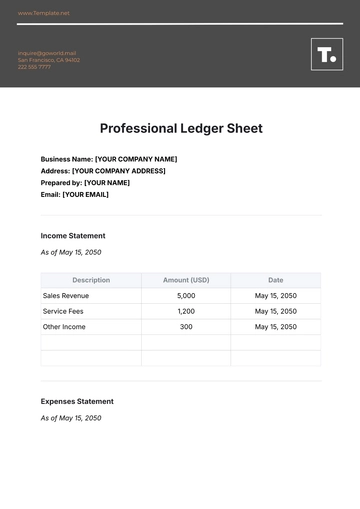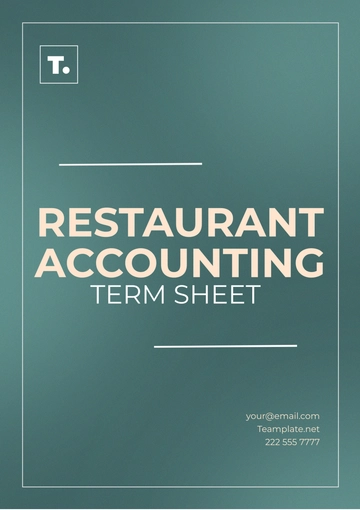Free Restaurant Accounting Term Sheet

I. Overview
This Restaurant Accounting Term Sheet outlines the essential financial and accounting terms pertinent to the operations of [YOUR RESTAURANT'S NAME]. As a guiding document, it aims to assist [YOUR COMPANY NAME] in maintaining accurate financial records and compliance with applicable accounting standards. The term sheet covers various critical areas such as cost management, inventory valuation, cash flow, and taxation specific to the restaurant industry.
By adhering to the guidelines captured in this term sheet, [YOUR RESTAURANT'S NAME] will be better equipped to manage financial challenges efficiently, ensuring sustainability and profitability in a competitive sector.
II. Key Financial Terms and Definitions
Understanding specific financial terms is crucial for accurate accounting and financial reporting. Below are fundamental definitions that [YOUR RESTAURANT'S NAME] should incorporate in its finance and accounting procedures:
Cost of Goods Sold (COGS): Represents the direct costs attributable to the production of the goods sold by the restaurant. This typically includes the cost of the ingredients and direct labor costs involved in their preparation.
Gross Margin: Calculated as Gross Revenue minus COGS. This metric helps in understanding the profitability of [YOUR RESTAURANT'S NAME] excluding overheads and other indirect costs.
EBITDA: Earnings before interest, taxes, depreciation, and amortization. This key indicator helps measure the overall financial performance of the restaurant.
III. Labor Cost Management
Efficient management of labor costs is vital for the sustainability of [YOUR RESTAURANT'S NAME]. Labor often constitutes a significant portion of the total operating expenses in the restaurant industry. The following strategies are recommended:
Utilize labor scheduling software to match staffing needs based on forecasted business volumes.
Regular training and performance assessments to enhance employee efficiency.
Implement incentive programs to motivate staff and reduce turnover rates.
IV. Inventory Valuation Methods
The choice of inventory valuation method can affect financial statements and tax obligations. [YOUR RESTAURANT'S NAME] should consider the following methods tailored for restaurant operations:
First-In, First-Out (FIFO): Assumes that the first items purchased are the first ones sold. This method can be beneficial during periods of inflation.
Last-In, First-Out (LIFO): Assumes that the last items purchased are the first sold. This method could be advantageous for tax purposes if prices are rising.
Average Cost: This method averages out the cost of goods available for sale during the period for the cost of goods sold estimation.
V. Cash Flow Management
Effective cash flow management is crucial for the operational integrity and financial health of [YOUR RESTAURANT'S NAME]. Ensuring that sufficient cash is available to cover daily operations, invest in growth, and meet emergency outlays is fundamental. Key considerations include:
Maintaining a detailed and real-time cash flow forecast.
Regular review and analysis of cash flow statements to identify trends and address any deviations promptly.
Optimize accounts receivable and payable to maintain a healthy cash flow balance.
VI. Taxation
Compliance with federal, state, and local tax laws is mandatory for [YOUR RESTAURANT'S NAME]. Understanding unique tax obligations such as sales tax on meals, payroll tax, and tips reporting is crucial. Key tax considerations are:
Regular updates from a tax advisor familiar with restaurant operations to keep informed on current tax laws and implications.
Conduct quarterly tax reviews and planning to ensure compliance and optimization of tax positions.
VII. Conclusion
This Term Sheet serves as a foundational guide for [YOUR RESTAURANT'S NAME] to manage its accounting functions effectively. Adherence to the guidelines presented will aid in ensuring financial discipline and regulatory compliance, fostering a robust business model poised for success.
- 100% Customizable, free editor
- Access 1 Million+ Templates, photo’s & graphics
- Download or share as a template
- Click and replace photos, graphics, text, backgrounds
- Resize, crop, AI write & more
- Access advanced editor
Explore the Restaurant Accounting Term Sheet Template on Template.net, tailored for efficient restaurant financial management. This editable and customizable tool simplifies financial tracking and reporting. Effortlessly modify and personalize the template using our AI Editor Tool. Streamline accounting processes, track expenses accurately, and easily optimize financial documentation. Enhance efficiency and organization in restaurant finances using this comprehensive and versatile resource.
You may also like
- Attendance Sheet
- Work Sheet
- Sheet Cost
- Expense Sheet
- Tracker Sheet
- Student Sheet
- Tracking Sheet
- Blank Sheet
- Information Sheet
- Sales Sheet
- Record Sheet
- Price Sheet
- Plan Sheet
- Score Sheet
- Estimate Sheet
- Evaluation Sheet
- Checklist Sheet
- Bid Sheet
- Call Log Sheet
- Bill Sheet
- Assessment Sheet
- Task Sheet
- School Sheet
- Work From Home Sheet
- Summary Sheet
- Construction Sheet
- Cover Sheet
- Debt Spreadsheet
- Debt Sheet
- Client Information Sheet
- University Sheet
- Freelancer Sheet
- Bookkeeping Sheet
- Itinerary Spreadsheet
- Scorecard Sheet
- Run Sheet
- Monthly Timesheet
- Event Sheet
- Advertising Agency Sheet
- Missing Numbers Worksheet
- Training Sheet
- Production Sheet
- Mortgage Sheet
- Answer Sheet
- Excel Sheet



